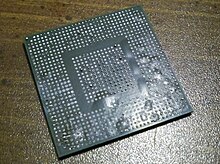Moisture Sensitivity Level
The Moisture Sensitivity Level ( MSL , dt. » Moisture Sensitivity Threshold«) relates to the moisture sensitivity of semiconductor components during packaging , storage and assembly .
background

Plastic- coated SMD components are not hermetically sealed, so that moisture from the room climate can diffuse into the plastic. If such moisture-laden components are soldered onto circuit boards by means of reflow soldering , the so-called popcorn effect can occur. The enclosed moisture evaporates almost suddenly when heated (soldering temperatures up to over 250 ° C with an increase of up to 3 K / s ). Since the hot steam leads to an increase in pressure, this can lead to components bursting or delamination within the housing structure. The same problem arises with desoldering.
As a preventive measure, the manufacturer of the SMD components uses the MSL to specify the conditions under which the components are to be stored and how they must then be processed.
standardization
| Threshold | Floor life | |
|---|---|---|
| time | condition | |
| 1 | unlimited | 30 ° C / 85% RH |
| 2 | 1 year | 30 ° C / 60% RH |
| 2a | 4 weeks | 30 ° C / 60% RH |
| 3 | 168 hours | 30 ° C / 60% RH |
| 4th | 72 hours | 30 ° C / 60% RH |
| 5 | 48 hours | 30 ° C / 60% RH |
| 5a | 24 hours | 30 ° C / 60% RH |
| 6th | "Time on label" (TOL) |
30 ° C / 60% RH |
| N | Not moisture sensitive according to JEDEC-J-STD |
|
The MSL can be determined in a number of ways. The standard J-STD-020 ( Moisture / Reflow Sensitivity Classification for Nonhermetic Solid State Surface Mounted Devices ) of the American organization JEDEC is used most frequently .
For handling, packaging, transport and the use of moisture-sensitive (SMD) components, see J-STD-033c .
When determining the MSL, components are first completely dried. Then they are loaded with moisture in a defined manner and then subjected to one or more reflow soldering processes. Electrical measurements or other examination methods (e.g. ultrasonic testing ) are used to check whether the components have survived the soldering process without damage.
The component must then be processed within the specified time periods without being damaged during the soldering process.
Handling guidelines
- The supplier delivers components ( e.g. microcontrollers ) welded and packaged. The packaging (dry pack) is checked for leaks and the LEVEL notice is checked. In the event of leaks, a drying process (baking) must be carried out, see below. The LEVEL notice label indicates the level with which the item is to be treated after the dry pack has been opened and when the sale date was. The moisture protection packaging itself consists of a desiccant and a moisture indicator card, which are (heat) sealed (welded) together with the SMD components in a moisture barrier bag ( MBB ).
- When the parts are removed from the dry pack, the floor life begins - the time within which safe processing without further drying processes is possible with a realistically defined room climate (see table). For example, if an article is delivered with 504 pieces, but the current requirement is only 252 pieces, the time after opening the packaging must be precisely documented (e.g. removal on May 13, 2009 10:15 am ). As mentioned above, for. B. LEVEL 3 to be used within 168 hours of opening. For this purpose, the removal date and the removal time are noted on the article.
- There is also the option of sealing the item again in moisture-proof packaging after it has been removed from storage. Because as soon as the article is packed airtight again, the LEVEL time stops again. The remaining time only expires when the packaging is open (materials removed from storage, during production on the machine, during return storage, etc.). When sealing the moisture protection bag, in practice it is not necessary to extract the air; however, slightly sucking out the air can reduce the packing volume. Complete evacuation of the air (vacuuming) is not permitted, as this impairs the desiccant and the performance of the moisture indicator and makes it easier for the moisture protection bag to be pierced (according to J-STD-033c).
- If overhang material is returned, the article can be (heat) sealed again in moisture protection packaging; the remaining storage time is of course no longer the same as in the delivery condition, but also only the remaining storage time (e.g. 72 hours). This means that the actual remaining time must be noted on the dry pack packaging.
- The only way to extend the time again is by baking the product according to the supplier's instructions (e.g. 192 hours at 40 ° C or 24 hours at 125 ° C). If the article is vacuum-sealed immediately after baking, the starting level (in the example: level 3) is reached again and the 168 hours are again the guideline for the next opening of the packaging.
Web links
- IPC / JEDEC J-STD-020D-01 jedec.org , March 2008 (PDF file; 176 kB)
